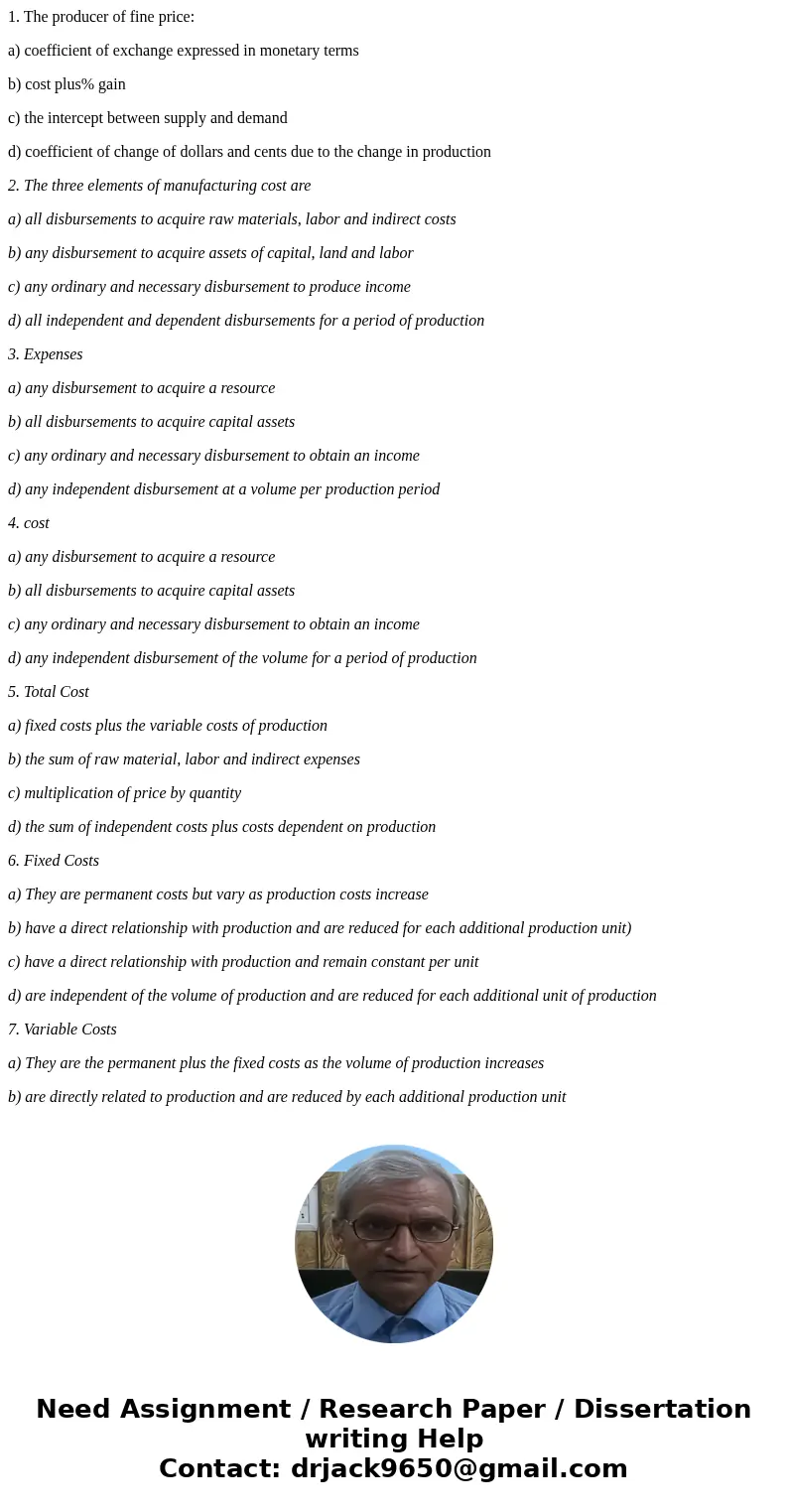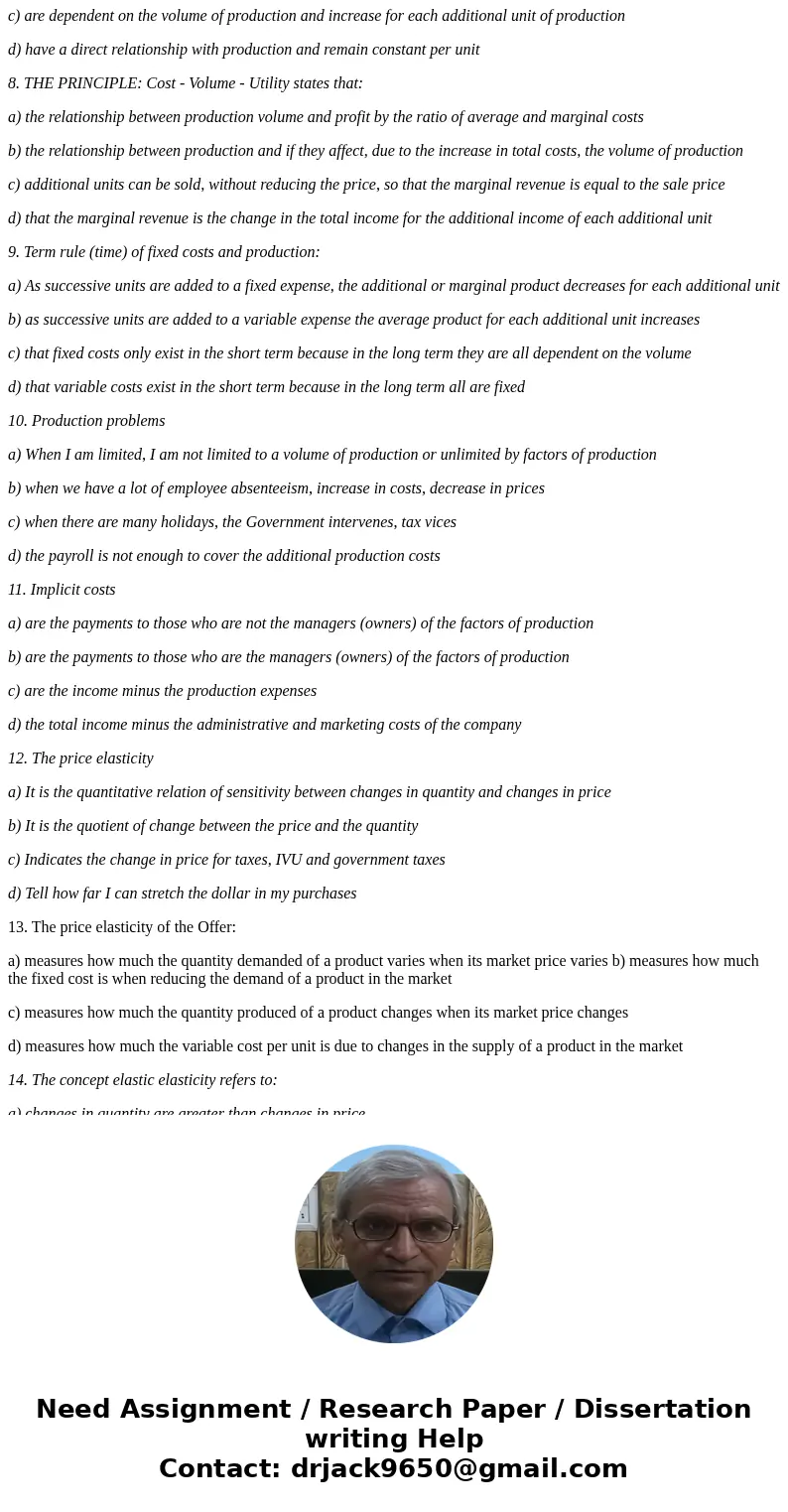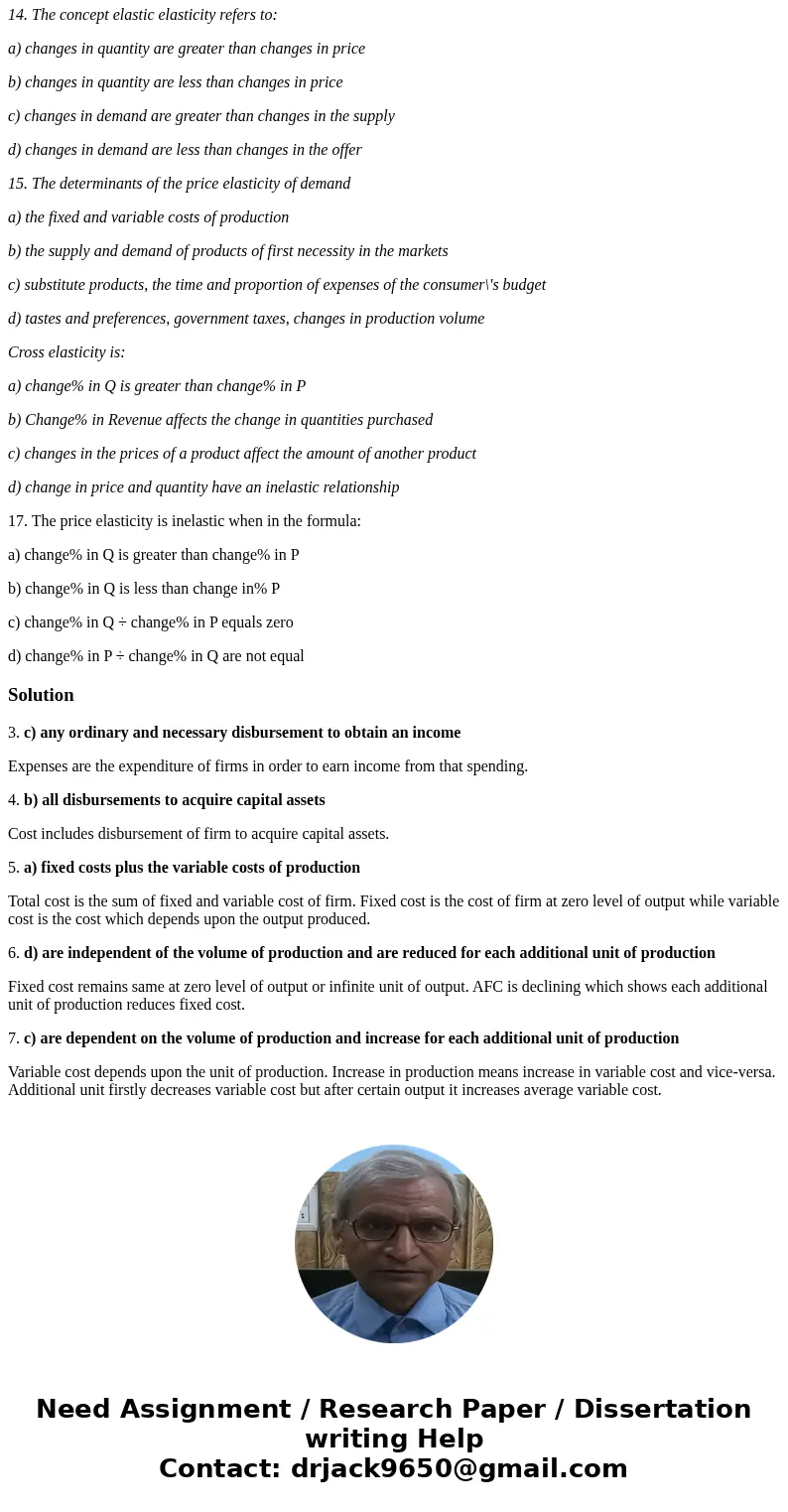1 The producer of fine price a coefficient of exchange expre
1. The producer of fine price:
a) coefficient of exchange expressed in monetary terms
b) cost plus% gain
c) the intercept between supply and demand
d) coefficient of change of dollars and cents due to the change in production
2. The three elements of manufacturing cost are
a) all disbursements to acquire raw materials, labor and indirect costs
b) any disbursement to acquire assets of capital, land and labor
c) any ordinary and necessary disbursement to produce income
d) all independent and dependent disbursements for a period of production
3. Expenses
a) any disbursement to acquire a resource
b) all disbursements to acquire capital assets
c) any ordinary and necessary disbursement to obtain an income
d) any independent disbursement at a volume per production period
4. cost
a) any disbursement to acquire a resource
b) all disbursements to acquire capital assets
c) any ordinary and necessary disbursement to obtain an income
d) any independent disbursement of the volume for a period of production
5. Total Cost
a) fixed costs plus the variable costs of production
b) the sum of raw material, labor and indirect expenses
c) multiplication of price by quantity
d) the sum of independent costs plus costs dependent on production
6. Fixed Costs
a) They are permanent costs but vary as production costs increase
b) have a direct relationship with production and are reduced for each additional production unit)
c) have a direct relationship with production and remain constant per unit
d) are independent of the volume of production and are reduced for each additional unit of production
7. Variable Costs
a) They are the permanent plus the fixed costs as the volume of production increases
b) are directly related to production and are reduced by each additional production unit
c) are dependent on the volume of production and increase for each additional unit of production
d) have a direct relationship with production and remain constant per unit
8. THE PRINCIPLE: Cost - Volume - Utility states that:
a) the relationship between production volume and profit by the ratio of average and marginal costs
b) the relationship between production and if they affect, due to the increase in total costs, the volume of production
c) additional units can be sold, without reducing the price, so that the marginal revenue is equal to the sale price
d) that the marginal revenue is the change in the total income for the additional income of each additional unit
9. Term rule (time) of fixed costs and production:
a) As successive units are added to a fixed expense, the additional or marginal product decreases for each additional unit
b) as successive units are added to a variable expense the average product for each additional unit increases
c) that fixed costs only exist in the short term because in the long term they are all dependent on the volume
d) that variable costs exist in the short term because in the long term all are fixed
10. Production problems
a) When I am limited, I am not limited to a volume of production or unlimited by factors of production
b) when we have a lot of employee absenteeism, increase in costs, decrease in prices
c) when there are many holidays, the Government intervenes, tax vices
d) the payroll is not enough to cover the additional production costs
11. Implicit costs
a) are the payments to those who are not the managers (owners) of the factors of production
b) are the payments to those who are the managers (owners) of the factors of production
c) are the income minus the production expenses
d) the total income minus the administrative and marketing costs of the company
12. The price elasticity
a) It is the quantitative relation of sensitivity between changes in quantity and changes in price
b) It is the quotient of change between the price and the quantity
c) Indicates the change in price for taxes, IVU and government taxes
d) Tell how far I can stretch the dollar in my purchases
13. The price elasticity of the Offer:
a) measures how much the quantity demanded of a product varies when its market price varies b) measures how much the fixed cost is when reducing the demand of a product in the market
c) measures how much the quantity produced of a product changes when its market price changes
d) measures how much the variable cost per unit is due to changes in the supply of a product in the market
14. The concept elastic elasticity refers to:
a) changes in quantity are greater than changes in price
b) changes in quantity are less than changes in price
c) changes in demand are greater than changes in the supply
d) changes in demand are less than changes in the offer
15. The determinants of the price elasticity of demand
a) the fixed and variable costs of production
b) the supply and demand of products of first necessity in the markets
c) substitute products, the time and proportion of expenses of the consumer\'s budget
d) tastes and preferences, government taxes, changes in production volume
Cross elasticity is:
a) change% in Q is greater than change% in P
b) Change% in Revenue affects the change in quantities purchased
c) changes in the prices of a product affect the amount of another product
d) change in price and quantity have an inelastic relationship
17. The price elasticity is inelastic when in the formula:
a) change% in Q is greater than change% in P
b) change% in Q is less than change in% P
c) change% in Q ÷ change% in P equals zero
d) change% in P ÷ change% in Q are not equal
Solution
3. c) any ordinary and necessary disbursement to obtain an income
Expenses are the expenditure of firms in order to earn income from that spending.
4. b) all disbursements to acquire capital assets
Cost includes disbursement of firm to acquire capital assets.
5. a) fixed costs plus the variable costs of production
Total cost is the sum of fixed and variable cost of firm. Fixed cost is the cost of firm at zero level of output while variable cost is the cost which depends upon the output produced.
6. d) are independent of the volume of production and are reduced for each additional unit of production
Fixed cost remains same at zero level of output or infinite unit of output. AFC is declining which shows each additional unit of production reduces fixed cost.
7. c) are dependent on the volume of production and increase for each additional unit of production
Variable cost depends upon the unit of production. Increase in production means increase in variable cost and vice-versa. Additional unit firstly decreases variable cost but after certain output it increases average variable cost.



 Homework Sourse
Homework Sourse